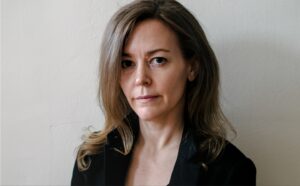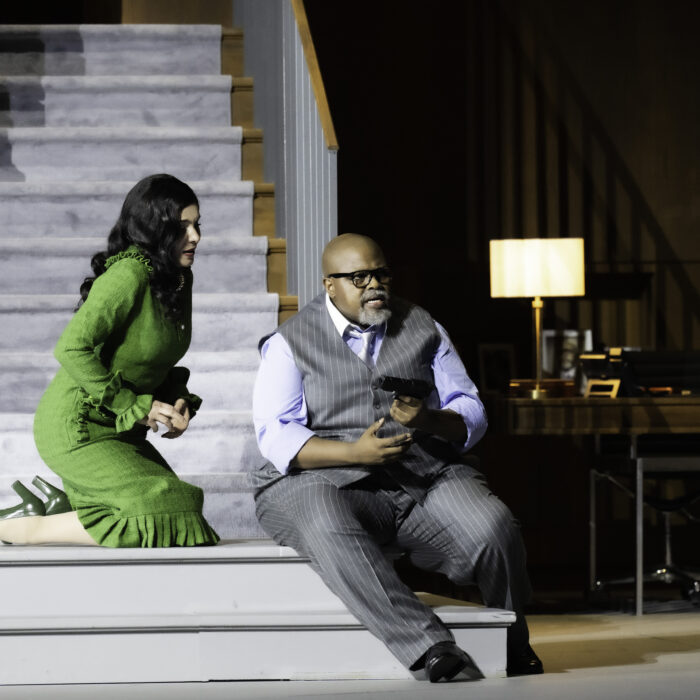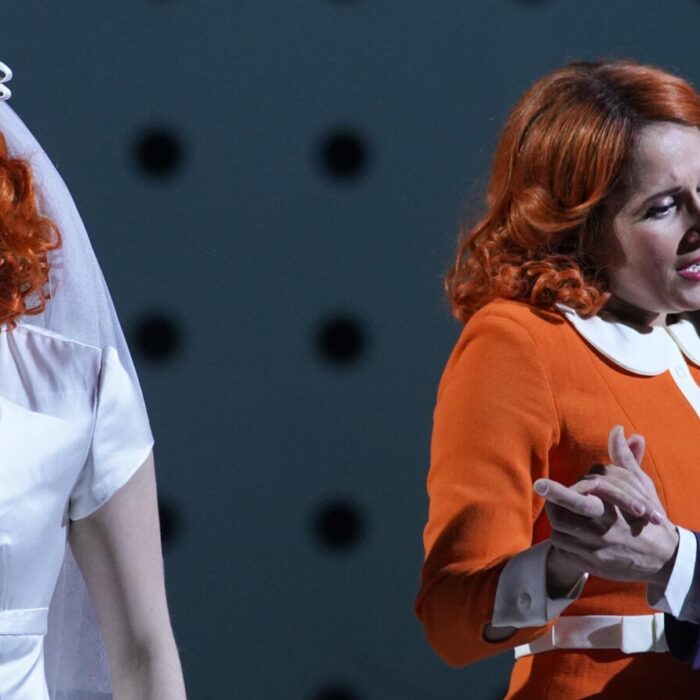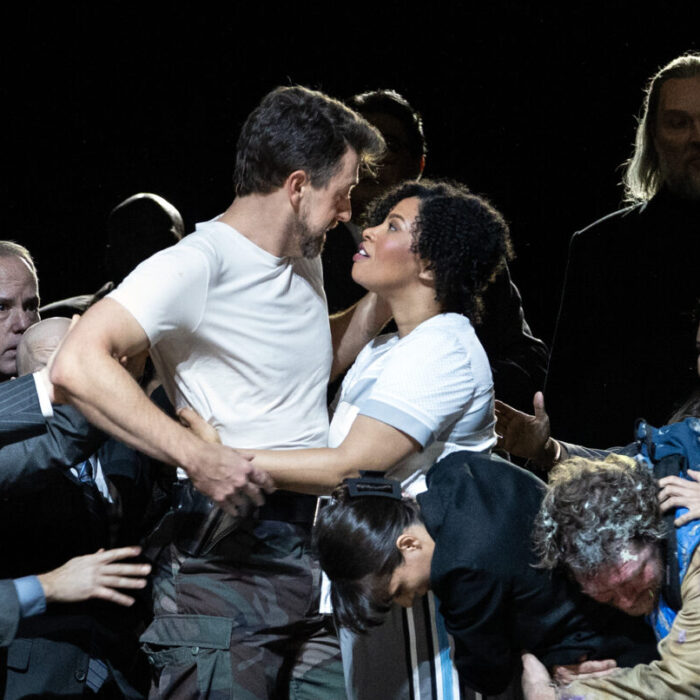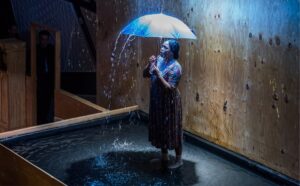
National Sawdust 2024 Review: Silent Light
World Premiere Production of Paola Prestini & Royce Vavrek’s Foley Chamber Opera Illuminates More Than Meets the Eye
By Jennifer Pyron(Photo credit: Jill Steinberg at National Sawdust)
National Sawdust’s 10th Anniversary opening season kicked off with Artistic Director/Co-Founder & composer Paola Prestini and librettist Royce Vavrek‘s foley chamber opera world premiere “Silent Light,” featuring director & scenic designer Thaddeus Strassberger and conductor Christopher Rountree.
The cast includes powerhouse soprano Brittany Renee as Esther, bass-baritone Daniel Okulitch as Johan, soprano Julia Mintzer as Marianne, tenor Anthony Dean Griffey as Zacarias, bass-baritone James Demler as Father, mezzo-soprano Margaret Lattimore as Esther’s mom, soprano Margaret Carpenter Haigh as Mother, tenor Tommy Wazelle as Cornelio, baritone Matthew Goinz as Alfredo, and children Nicole Barragan, Sofia Clotsos, Jack Lantin, Louise Lantin, and Eva E. Paliashchuk.
Foley designer Sxip Shirey and foley artist Nathan Repasz construct atmospheres of sound alongside vocalists of the Choir of Trinity Wall Street sopranos Margaret Carpenter Haigh, Meg Dudley, Madeline Healey, Elena Williamson, altos Jonathan May, Pamela Terry, tenors Garrett Eucker, Gregório Taniguchi, Tommy Wazelle, basses Matthew Goinz, Jalen Hicks and Paul Max Tipton.
The orchestra includes members from Novus NY and percussionist Marlon Patton, trombone & looper Dave Nelson, cellist Jeffrey Zeigler, violinist Katie Hyun, trumpeter Sam Jones, and rehearsal pianist Forrest Eimold. “Silent Light” is produced in partnership between VisionIntoArt and National Sawdust, and is co-commissioned by Trinity Church, Banff, and VisionIntoArt.
“Silent Light” is based on “Stellet Licht” (Silent Light, 2007) by Mexican filmmaker Carlos Reygadas. In the film Reygadas uses slow, long takes that embody the natural landscape and culture of a Mennonite community. His work acts as a mirror inside of the most intimate spaces between husband (Johan) and wife (Esther) as they navigate tumultuous emotions stemming from Johan’s affair with another woman (Marianne).
Reygadas’s film takes its time, allowing the drama to unfold and evolve similar to nature itself. Lush Mexican sunsets/sunrises of color, outdoor sounds, and subtle changes happening in real time act as the main characters while the film’s climax resolves within the body of nature as a greater whole. His perspective makes this film a perfect inspirational starting point for a new opera, and “Silent Light,” the opera, takes on this risk to embody it all.

Producing a Mennonite Community
American director and scenic designer Thaddeus Strassberger is well-known for his productions, including his most recent work as reviewed by OperaWire: his production of “Boris Godunov” at Tiroler Landestheater for the Innsbruck Festival of Early Music 2022-23. According to Strassberger’s bio he has created over 75 productions in more than fifteen countries, including (one that I would’ve loved to experience live) his production of Philip Glass’s “Satyagraha” in Russia. It won the 2014 Bravo Award for Best Production and two Golden Mask Awards.
Strassberger’s accomplished works precede him in a lot of ways, and one would hope producing an opera featuring a Mennonite community based on a film in the community’s natural setting would translate well for an opera’s dramatic framework. But how does one do this, and do it well?
It is important to take a closer look at this opera’s drama in comparison to the film’s original context and intention. The Mennonite community is not the same as the Amish community, including their traditional dress. According to Marcela Enns, a Mennonite in her 30s based in Cuauhtémoc City in Chihuahua, MX, in an interview featured in El Heraldo de Chihuahua, there are “many [Mennonites who] use electricity, vehicles, cell phones and the Internet.” This article also says, “Currently, around 33,000 Mennonites live in the municipality of Cuauhtémoc. Their life and beliefs are based primarily on peace, justice and non-resistance. Mennonites say that violence ‘is not the will of God’ referring to war, hostility between races and classes, child abuse, abuse of women and any type of violence; however, this does not mean that all Mennonites follow these doctrines.”
Reygadas’s film highlights the severe distress of a Mennonite family, and has actors in the film who are actually from the Mennonite community, bearing witness to the betrayal of a husband. The film allows the audience to experience the life of Mennonites in an unbiased approach and therefore, creates space for one to draw their own conclusion about why this act of betrayal is happening and if it will resolve.
“Silent Light,” the opera, focuses on the act of betrayal as the emotional ruin and, at times, self-sacrificing labor taken on by someone embodying their own spiraling grief. At one point, the opera production had women place cow-masks over their head and bend over so that the men could imitate milking their breasts. Once this scene was completed, the women stood up and took their masks off, revealing their red faces and perspiration. Their mouths fell open as they drew in cool breaths of air and released long sighs of desperation.
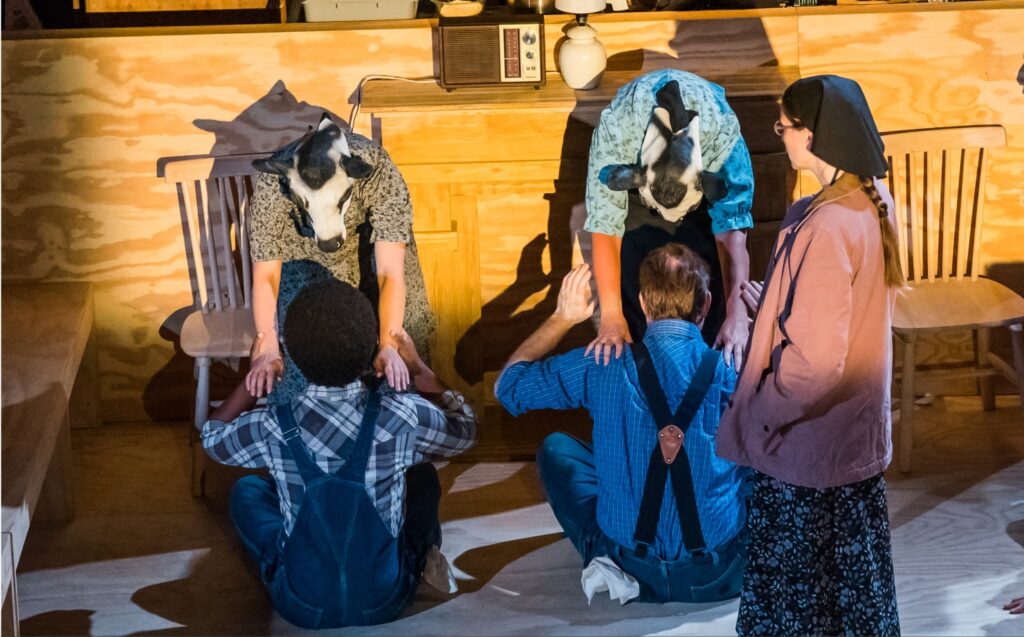
The production’s choices like this stand out, illuminating more than meets the eye and separating it from the transparency that makes Reygadas’s film timeless. This moment felt stuck in time, digging deeper into the biases that exist around adultery and even marriage itself as an act of “ownership.”
The drama continued to weigh heavily throughout the entire opera and Brittany Renee as Esther seemed to bear the force of it all. From the moment the audience is introduced to her character at the opening’s breakfast scene, there exists a sense of depression and unvoiced anger stirring within her. Her eyes are slow to rise and fall upon Johan, who is lost in his own thoughts. At times her eyes distanced themselves from focusing on anything at all, a glazed-over-state, resting lifelessly on the plate of food in front of her. Even as her children and mother sat around the table and ate, Esther was in another mental space. The emotional pull of this extreme amount of drama takes the reigns from early on and steers the opera headfirst into unknown territories – inviting the audience to question their own bias and the production’s choice of direction along the way.
The stage was beautifully constructed with raw wood and a pool of water that reflected light softly on the backwall of National Sawdust’s theater. There was also an abstract fixture of wooden panels suspended above the stage that created a sense of unease, falling apart at the seams, ready to collapse at any minute feeling.
The conductor, Christopher Rountree, and orchestra were to the side of the stage and the foley artist, Nathan Repasz, was at the opposite side, standing in front of a table with plenty of objects and instruments to satiate one’s sound palette.
A grandfather clock hovered nearby the long family-style table and Johan kept his eyes on it, watching and listening to time passing by, or just repeating itself in a loop. The sounds of the chairs moving on top of the wooden floor, breakfast being made at the built in stove area to the side, glasses and plates clinking on top of the table, mouths churning food that created an atmosphere of smells for the audience to take in. Everything about this production was open for one’s own interpretation through their senses and sensibility.
Prestini Creates the Body’s Score
Reygadas’s film did not include a score, apart from the natural sounds as mentioned above and the traditional Mennonite songs the cast sings during Esther’s wake. Therefore, Paola Prestini’s composition for “Silent Light,” the opera, makes up an interesting and inquisitive addition.
Prestini’s work as a composer is an ever-evolving process that involves thoughtful collaborations and boundary-pushing elements of design and technology. This can also be said about her legacy as Co-Founder and Artistic Director of National Sawdust (NS). Prestini and the entire NS team makes space and opportunities for artists who dare to dream big-bigger-biggest, possible. She celebrates the complexities of the human experience and supports the learning it takes to evolve and sometimes deconstruct as a way of creating less-is-more moments for audiences to feel part of something greater than first imagined.
“Silent Light” is the first performance of a full-length work by Prestini to be featured at NS. The Meyer Constellation sound system
OperaWire has reviewed several of Prestini’s compositions, including “The Glass Box,” “Voices,” and “Con Alma” (composed by Prestini and Magos Herrera). Her use of the human voice as an interpreter of the ethereal is perfectly showcased in “Silent Light”. One could tell she collaborated with the singers in this opera and worked from that point to compose what felt right for each voice in the moment. The scene during Esther’s wake when the choir claps and sings may have reminded one of the scene in Céline Sciamma’s film “Portrait of a Lady on Fire” (2019), as the women gathered around the fire in the moonlight’s searing glow.

The most intense part of this opera’s score climaxes (literally) during a sex scene involving Johan and Marianne. The characters enter the pool of water in a moment of rising lust and proceed to become one with the body of water, dancing on the back of the theater’s wall and shadowing the naked parts of one another’s bodies and vulnerable emotions. In the film this takes place in a hotel room while the children wait in a van outside in the parking lot. There are a lot of ways to interpret this moment, and the music that swells around during the opera expresses it fully. The horns grow louder, percussion drives harder, everything melts together into a wash of sound. The building up to this began when Marianne served Johan a warm cherry pie and cold, tall glass of milk (overflowing) at the family table. All of this to say, Prestini took many risks to make this score as alive as possible.
Foley designer Sxip Shirey and foley artist Nathan Repasz also developed this score into something more by taking up space with the Meyer Constellation sound system and even highlighting nuances that in a film are easier to capture than on a vast stage in an opera. There was a part during the cow-mask milking scene when Repasz used water guns to capture the sound of the water hitting a metal bucket, imitating the milk coming from the cows. For me personally, I found myself watching what Repasz was going to do next and wondering how he did it especially with the sound design technology and use of NS’s limitless space.
The realm of possibilities continued to expand and impact my thought process. Royce Vavrek’s libretto catapulted this drama forward and made moments of “quiet” heard. The Mennonite community in this opera especially made me question what would be allowed in regards to the drama that was unfolding on stage, stemming from the film’s open interpretation. “Silent Light,” the opera, is a living body reflecting what makes up some of life’s experiences and most of new opera’s evolutionary process along the way.
Brittany Renee’s Illuminating Performance
Soprano Brittany Renee takes on the very complex role of Esther in “Silent Light,” oscillating between internalizing her feelings and externalizing her inner voice. She creates a seamless balance that makes this opera multidimensional in different ways than the film. Renee embodies everything, everywhere, all at once, and her voice is a light unto the darkest parts.
OperaWire had the honor of reviewing her performance for Met Opera’s 2023-24 production of Terence Blanchard and Kasi Lemmons’s “Fire Shut Up in My Bones,” noting how “Brittany Renee faced the daunting task of portraying three distinct characters.” The same could be said about her role as Esther, transitioning through the various stages of grief and awakening at the end to a new dawn of existence. Renee is a master at discovering herself more and more with every performance she gives – and she gives her all.
The one moment I will forever cherish from this opera is when I watched Renee experiencing rainfall after her character got out of the car she was in with her husband (Johan) and felt her heart collapsing under an overwhelming amount of grief. When the rain began to fall and Renee stepped into the pool at the back of NS’s stage, she became a force of nature herself. She rotated her hands to observe the water trickling along her arms, taking over her chest, making paths between the hairs on her head.
Renee absolutely blew me away. Her tenderness and emotional intelligence is exactly what makes a person special during a live performance. I could not separate myself from imagining what the water felt like, how the internal pain resonated, and most especially when the breaking point would turn into the resolve that I wanted so badly for this character – the peace that precedes all understanding. I wanted this for her, and I wanted this for all, at the same time.
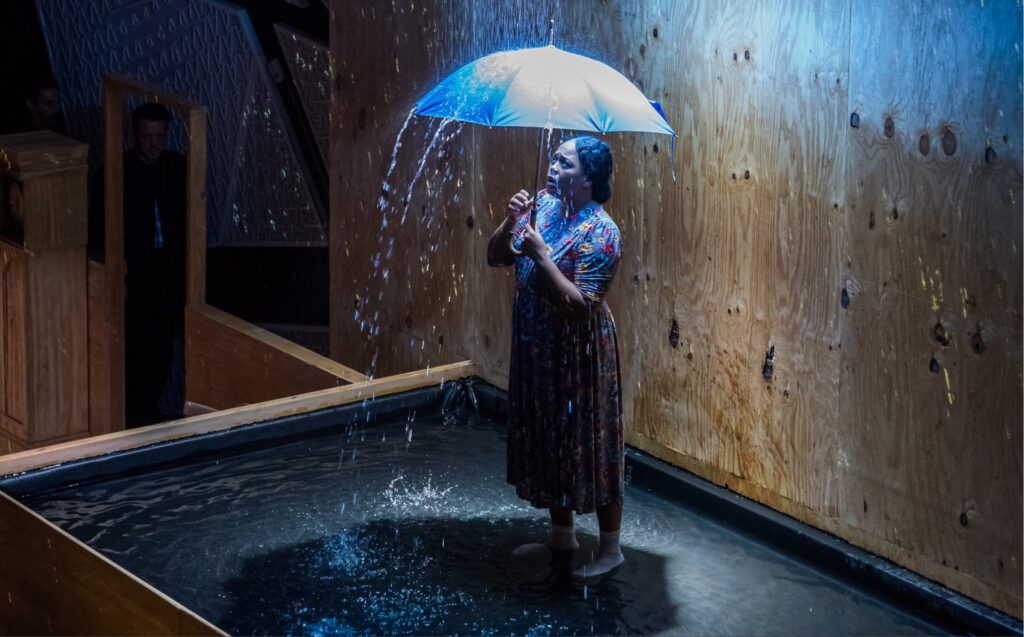
More Cast Highlights
Daniel Okulitch as Johan made his character a role of his own. His presence and slow movements when on stage took time from the clock that haunted him and put it into the the opera, creating gaps for interpretation and curiosity. Johan in this opera became less of the focus in comparison to Johan in the film. Okulitch’s bass-baritone resonated with the wooden interiors of the scenic design and, one might have felt, made Johan less transparent. There was always some thought process swirling behind Okulitch’s eyes, taking his attention from the present moment and facing it towards whatever was on his mind. I found it interesting to realize how emotions carry differently when a character is on stage. I felt like the movie made more sense out of Johan’s character than the opera, at times, simply because it just took things at a slower pace.
I noticed how a build-up of resentment towards Johan was stirring the whole time during the opera, but the intimacy scenes with Marianne seemed to exasperate this and take it over board into full on internal disgust. In the film there was sense of love in the air, in the opera there was a cloud of lust pulsing as it grew thicker and darker with its desire to consume.
Julia Mintzer as Marianne left a lasting impression every time she stepped onstage. Her eyes and body communicated it all very clearly and decideldy, while at the same time funneling an energy of force from within her. The opera ends with Marianne kissing Esther (just like the movie), and Esther waking up from the dead.
Once Esther’s body raises up from her bed and everyone realizes she is alive, Marianne is seen eyeing Johan from behind. This left open the interpretation for if Johan would continue his affair, or end it now that Esther is “given” back to him from the dead. This reminded me of Ovid’s “Metamorphoses” when Orpheus looks back at Eurydice and she falls into the realm of the dead’s abyss. Did this look-back from Marianne represent Johan’s eminent death-to-rebirth now that Esther was alive? How could Johan go back to the way things were? His past behaviors paled in comparison to the gift of life.
Tenor Anthony Dean Griffey as Zacarias, bass-baritone James Demler as Father, mezzo-soprano Margaret Lattimore as Esther’s mom, and soprano Margaret Carpenter Haigh as Mother all gave fantastic performances, breathing life into the libretto in interesting ways.
Tenor Tommy Wazelle as Cornelio and baritone Matthew Goinz as Alfredo were excellent in their roles, and children Nicole Barragan, Sofia Clotsos, Jack Lantin, Louise Lantin, and Eva E. Paliashchuk really give “Silent Light” the innocence and levity it needs.
“Silent Light” is a first of its kind in realizing the value of sound and immersive theater (especially with NS’s Meyer Constellation sound system), determining what more than meets the eye and where the future of opera is looking to next.
